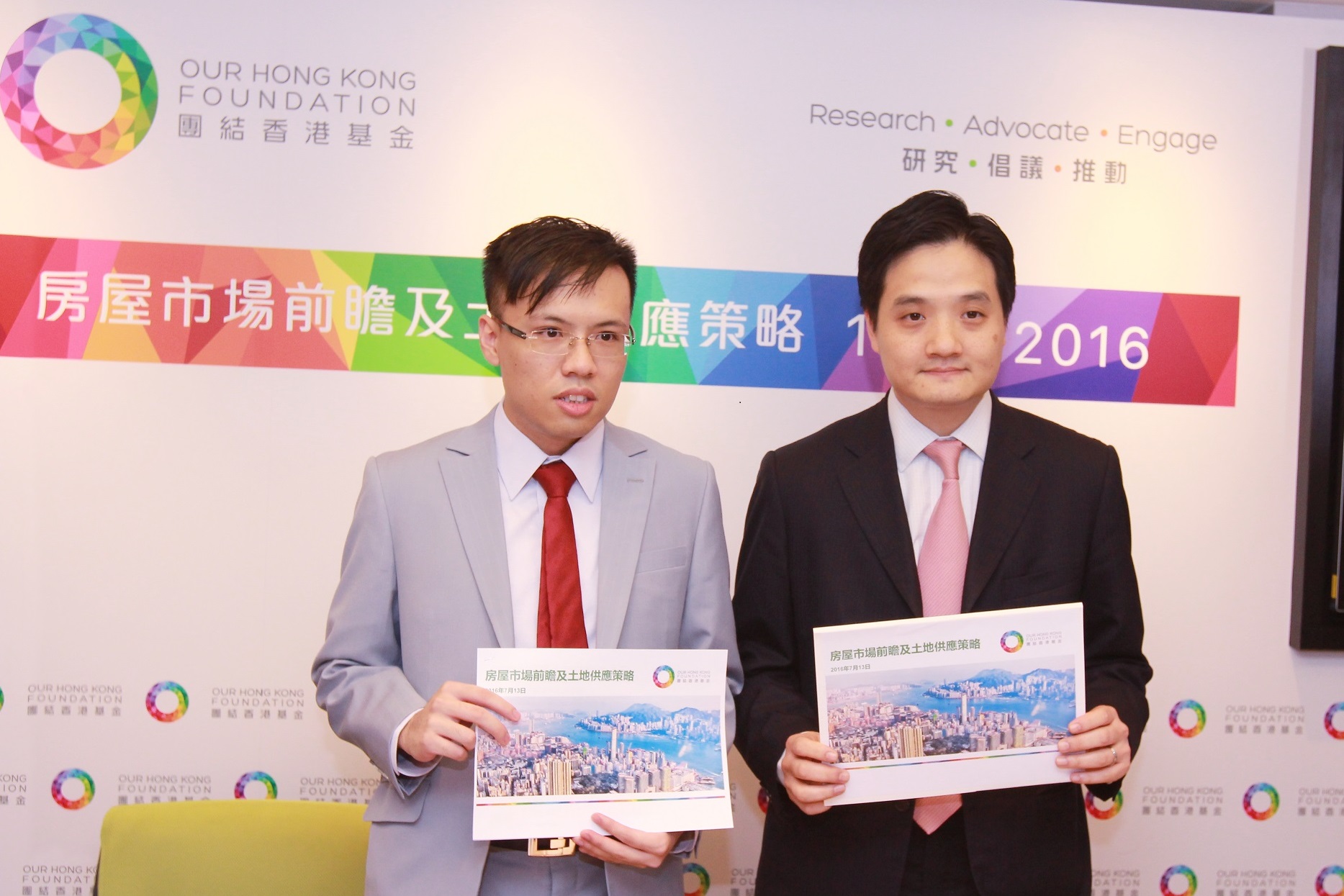Our Hong Kong Foundation From Housing Market Outlook to Land Supply Strategy
Our Hong Kong Foundation (OHKF) released findings from its research “From Housing Market Outlook to Land Supply Strategy” today, which points out that despite an expected increase in near-term housing supply, the latest demographics and other socio-economic indicators demonstrate that there is a substantial housing demand yet to be met, hence the government must continue to provide land and housing supply. OHKF also believes that brownfield sites shall not be considered the priority avenue of land supply due to difficulty of their development. Instead, reclamation and developing new towns are more effective ways to provide developable land in the long term.
William Wai-him Tsang, Senior Researcher at OHKF, forecasts that in 2016 – 2019 the annual average completion of new private housing units will be approximately 18,000 units. This represents a 60%-increase compared with the previous decade. Examining the four sources of government-led residential land supply, namely land auction and tender; Mass Transit Railway Corporation (MTRC); the Urban Renewal Authority (URA), and the Hong Kong Housing Society (HKHS) over the past seven years, it was found that an annual average of more than 14 million square feet (sf) of residential gross floor area (GFA) was provided in the two years of 2014 and 2015. This denotes a 75%-increase from the average of the preceding three years.
OHKF also points out market competition has intensified since the abolishment of the “Application List System” and the re-introduction of government-initiated land sales. In the period from 2009 to 2015, the share of the total residential GFA successfully sold or tendered to the three largest participants decreased from about 70% to 90% to only about 50%. An increase in the number of market participants may have encouraged housing units to reach the market faster.

and William Wai-him Tsang, Senior Researcher at OHKF, explain the findings of their research to the media.
Data analysis over the past 30 years suggests that at the present, there is an immense and substantial demand for housing yet to be met. For example, from 2011 to 2015, the combined average annual number of first marriages, live births (excluding births from singly and doublynon-permanent residents), and divorces is higher than the corresponding figure for the period from 1986 to 1995. In other words, demographic-driven housing demand in recent years is higher than in the 1980s and 1990s. However, a comparison of the two periods shows that overall housing units’ completion plummeted by 60%. In addition, the supply of public housing units is trailing behind. In particular, it is estimated that a total of 100,000 public housing units will be completed within the five-year period from 2016 to 2020, falling 30% short of the target stipulated in the “Long Term Housing Strategy”.
OHKF establishes that the lack of large-scale land development projects over a prolonged period of time in the city is one of the major constraints facing current housing supply. Over 70% of government land auction / tender in 2012, as measured by GFA, originated from reclaimed land from the 1990s or from developable land in the previous generation of new towns. By 2015, these sites encompassed only 50% of the overall figure. On the contrary, land that needs to go through the town planning processes of rezoning for development, such as slopes, government sites (such as former staff quarters) and work sites, surged from 8% of the total residential GFA in 2012 to 41% in 2015. This reflects that readily developable government land is dwindling, and therefore the government is increasingly relying on change of land use as a source of land supply. In addition, smaller sites are seldom conducive to development, indirectly pushing up construction costs, which will ultimately affect housing prices.
Regarding the land supply strategy, OHKF does not subscribe to the view that the government should only consider other land supply options such as reclamation after current brownfield sites are developed. In light of the serious shortage of land, OHKF supports the notion that the utilization of land resources must be improved and the call for a review of the existing use of Brownfield sites. However, OHKF does not support the concept of “Brownfield First” or policy prioritizing any particular source of land supply. This is because any method to increase land supply will ultimately be faced with an assortment of challenges and difficulties. Take brownfield sites as an example, such large-scale, systematic development will naturally involve land resumption, relocation, resettlement, and compensation, which could be extremely time-consuming. In fact, public housing projects involving similar issues typically require an exceedingly long lead-time. Such examples include the redevelopment of Yuen Long Estate and Kwai Chung Former Police Quarters, as well as the development of Tsz Tin Tsuen, which took nearly 10 years from land resumption to the completion of project. OHKF believes that reclamation and new town development are still effective ways to increase land supply in the long term.
Stephen Yuen-shan Wong, OHKF Deputy Executive Director and Head of Public Policy, points out that the research findings warrant concerns over Hong Kong’s land and housing supply. “Whilst the supply of private housing units in the near term could reach the target set by the government, that of public housing is obviously trailing,” he said. “Moreover, according to OHKF’s first research report on land and housing, the city would need to develop more than 9,000 hectares of land over the next three decades, if we were to improve the living standards and community facilities enjoyed by the Hong Kong people. This underscores the importance of the establishment of a land reserve. We hope that future government planning would entail a more visionary and longer-term view on Hong Kong’s development needs.”
The research “From Housing Market Outlook to Land Supply Strategy” is a follow-up to OHKF’s first “Land and Housing” research, the objective of which is to provide updated data on housing and land supply so that the community could have a clear understanding of the situation. OHKF’s first “Land and Housing” research was released in November 2015, which mainly suggested the government should implement “Subsidized Homeownership Scheme” in order to assist public-housing households in becoming owners of their properties, and support a multi-pronged approach to increasing land supply.



